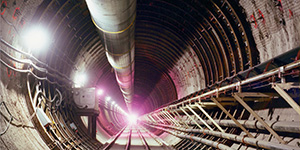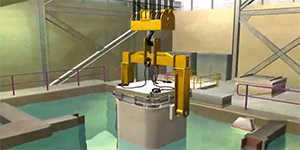The end stage of the nuclear fuel cycle
All designs of nuclear reactors provide for safe used fuel storage for several decades, but not for permanent long-term storage or disposal. Dry storage facilities have significantly extended those timeframes, but they cannot accommodate the need to safely isolate high-level wastes from the environment for the thousands or perhaps hundreds of thousands of years required.
The nuclear industry has been studying the issue of long-term disposal or storage for many decades. International consensus is that deep geological repositories – carefully engineered with multiple barriers and located hundreds of meters beneath the earth’s surface in granite, salt or clay – will be the most effective means to safely dispose of these materials.
At present, no long-term repositories have been constructed anywhere in the world. The process of selecting appropriate deep geological repositories is underway in several countries. Finland, Sweden and France are the furthest advanced with plans for direct disposal of used fuel. It is expected the first repository will become operational in the 2020’s.
In Canada, a research program led by Atomic Energy of Canada Limited (AECL) was launched in 1975 to develop a concept for disposing of high-level wastes deep in the Canadian Shield. Research was conducted until about 1998 at which time a panel of technical experts and non-technical representatives reviewed the disposal concept. The panel stated that the safety of the concept had been demonstrated from a technical point of view, but not from a social perspective. As the concept did not have broad public support, it was not considered acceptable as Canada's approach for disposing of nuclear waste.
After receiving input from various stakeholders and the public, the federal government introduced nuclear fuel waste legislation in April 2001, requiring nuclear utilities to establish a separate waste management organization to manage the disposal of nuclear fuel waste.
The Nuclear Waste Management Organization (NWMO) was established in 2002 to assess disposal alternatives including the option of long-term centralized storage, as well as establish a comprehensive public participation program. In November, 2005, the NWMO concluded the first phase of its mandate by submitting its recommendations to the Minister of Natural Resources Canada.
After a comprehensive three year study, the NWMO recommended Adaptive Phased Management for the long term care of Canada's used nuclear fuel.

In the USA, the government had approved a repository at Yucca Mountain in Nevada in 2002. However, bowing to eight years of public pressure, in 2010, the US Department of Energy took a step back and chartered the Blue Ribbon Commission on America’s Nuclear Future. The Commission was mandated to conduct a comprehensive review and develop recommendations for the management and eventual disposal of high-level nuclear waste. They delivered their recommendations in January, 2012.
The US Department of Energy responded to the recommendations in January 2013, releasing “Strategy for the Management and Disposal of Used Nuclear Fuel and High-Level Radioactive Waste”. In it, they outline a phased, adaptive, and consent-based approach to siting and implementing a comprehensive management and disposal system.
Both Canada and the United States have committed to using approaches to site selection that ensure:
- safety and security for people and the environment, now and long into the future
- openness, transparency, and fairness
- consultations will be inclusive
- the process will be consent-based and a final selection made with agreement of a willing host community







